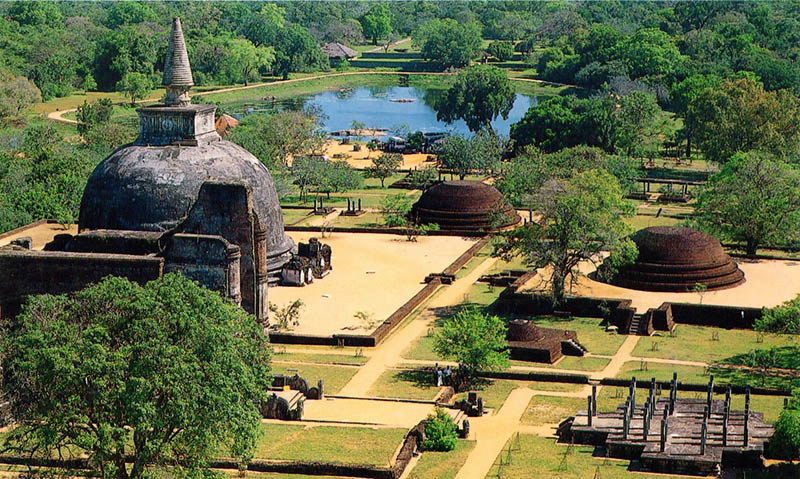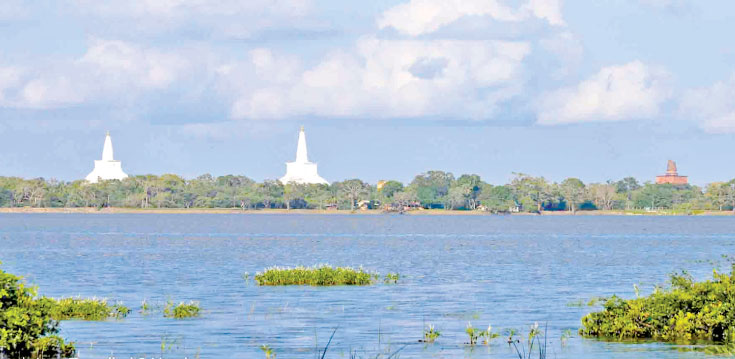Documented history of Sri Lanka dates back to 3rd c. B.C. when the island was among the most advanced and developed nations of the pre-modem world and the seat of an important historical civilization in Asia. The ruined cities of Anuradhapura, Polonnaruwa and Sigiriya extending from 3rd c. B.C. to 12th c. A.D. record a grandeur unsurpassed.
 The gentle way of Buddhism introduced in 247 c. B.C. which, transformed the Indo-Aryan Sinhalese has produced magnificent feats of architecture and construction. In the massive dagabas, the ornate pleasure gardens and palaces and the exquisite sculpture which abounds, particularly at Anuradhapura. Sri Lanka's ancient cities are also the centres of the irrigation works of the past. Massive reservoirs built to collet rain water, river diversions, giant aqueducts and miles long irrigation channels are proof of a civilization highly developed in the science of irrigation, hydraulics and water management.
The gentle way of Buddhism introduced in 247 c. B.C. which, transformed the Indo-Aryan Sinhalese has produced magnificent feats of architecture and construction. In the massive dagabas, the ornate pleasure gardens and palaces and the exquisite sculpture which abounds, particularly at Anuradhapura. Sri Lanka's ancient cities are also the centres of the irrigation works of the past. Massive reservoirs built to collet rain water, river diversions, giant aqueducts and miles long irrigation channels are proof of a civilization highly developed in the science of irrigation, hydraulics and water management.
Sri Lanka' first capital, founded in the 5th c B.C. according to the ancient Sinhala chronicle Mahawansa, was a model of planning with precincts set aside for huntsmen,scavengers. heretics as well as for foreigners. There were separate cemeteries for high and low castes, hostels and hospitals.
 Anuradhapura was an example par excellence of a Hydraulic Civilization. The construction of reservoirs, canals and irrigation channels during this period exhibited an amazing knowledge of trigonometry and the design of reservoirs a thorough grasp of hydraulic principles. The ornamental scale of the large reservoirs is compelling evidence of a thriving economy and a state structure which had resources from an agricultural surplus and profits from trade to invest in these projects as well as on religious and public buildings designed on a lavish scale.
Anuradhapura was an example par excellence of a Hydraulic Civilization. The construction of reservoirs, canals and irrigation channels during this period exhibited an amazing knowledge of trigonometry and the design of reservoirs a thorough grasp of hydraulic principles. The ornamental scale of the large reservoirs is compelling evidence of a thriving economy and a state structure which had resources from an agricultural surplus and profits from trade to invest in these projects as well as on religious and public buildings designed on a lavish scale.
The unique feature of Buddhist Sri Lanka is the Stupa (Dagoba), which eenshrined relics of the Buddha and were objects of veneration. It is generally a solid, hemispherical dome, which expresses the serenity and simplicity the quintessence of Buddhism. The ‘Rajarata’ – the King’s country is dotted with these stupas and the picturesque lakes which has an irresistible charm for the visitor. There are many important stupas at Anuradhapura.
Abayagiri and Jethavana Stupas

The Abayagiri Stupa (meaning mountain of valour) built by the warrior King Valagam Bahu in the 1c. B.C. and Jethavana Stupa built by King Mahasen in the 3c. A.D. were taller than the third pyramid of Giza and were the wonders of the world at the time, with the Jethavana probably being the largest stupa in the whole Buddhist world.Thuparama StupayaThis stupa is the first to be built in ancient Sri Lanka by King Devanampiyathissa since the introduction to Buddhism in 3rd Century BC.Lovamahapaya King Devanampiyatisse built the first chapter house a century later King Duttagamini
Thuparama Stupaya

This stupa is the first to be built in ancient Sri Lanka by King Devanampiyathissa since the introduction to Buddhism in 3rd Century BC.
Lovamahapaya

King Devanampiyatisse built the first chapter house a century later King Duttagamini built what can be seen at present. King Parakramabahu I (1153-1186 AD) raised again its 1600 stone pillars and restored the building with a copper roof.
The Ancient Bridge of Stone
This stone bridge runs across the Malwathu Oya (river). The stone slabs and pillars of their bridge are found for a distance of closed by on the bank of this river. The stones slabs and pillars are laid at a same distance. The stones are laid as beams on rows of each pillar.
Mirisavatiya Stupa

This stupa can be seen in front of the Tissavava Rest House. This stupa was built by King Dutugemunu (161-137 B.C) which was his first construction of stupa. This was reconstructed and restoration by the Department of Archeology in 1993.
Lankaramaya Stupa
This stupa is originally built by king Walagamba in the first century B.C. in the Abhayagiri Monaster complex. This Dagaba has being reconstructed.
Dakkina Stupa
This large brick mound structure which remains incomplete as a stupa, was until recently called the tomb of King Elara. It was identified in the excavation in 1946 as the dhakkina stupa by the vetaran archeologist Dr. Senarath Paranavitana. This site was the place where the King Duttagamini was cremated. The original Dagaba was a small one.
Isurumuniya (Meghagiri Vihara)

The Meghagiri Vihara which is called the Isurumuni vihara was the first repository of the Tooth Relic. This was belonged to the Abayagiri Vihara in the 4th Century A.D.
Vessagiriya (Issara Samanarama)
This site presently known as vessagiri was called the Issara Samanarama in the ancient time. There are many rock caves alone served as shelter for Buddhist Monks in the first and second centuries.
Abayagiri Museum
There is a Abhayagiri Museum constructed by the Central Cultural Fund. Close to the Abhayagiri Stupa there are many artifacts and ruins in the museum. This Abhayagiri site museum is named after Fashein of china who came to Sri Lanka 5th century A.D and stayed at Abhayagiri Monastery.
The Ruwanveliseya Dagoba

Built by King Dutugemunu in 2c. B.C. is by far the most beautiful its white dome shinning like a pearl in the dry, arid landscape. The Thuparama Dagoba is the most ancient of Sri Lanka’s dagobas and was built by King Devanampiyatissa to enshrine the Buddha’s collar bone. Its present ‘bell’ shape dates to reconstruction in the 1840’s.
The Samadhi Buddha

This 4c. A.D. statue of the Buddha in meditation pose is acknowledged world wide as a masterpiece of sculpture. The Brazen Palace (Lovamahapaya) – a roof of copper bestowed the name given to this building which burned down only 15 years after its construction in the 3c.B.C. The 1,600 pillars, in 40 rows, that now mark the site are ascribed to King Parakramabahu (12c.). The original building of nine graded storeys is said to have been 100 cubits square at ground level and 100 cubits high.
Kuttam Pokuna

These twin ponds are among the handsomest works of the Anuradhapura period. The Mirisavetiya Dagoba, was built on the spot where King Dutugemunu buried his spear containing a relic of the Buddha, after celebrating his victory in battle on the shores of the Tissa Wewa.
Sri Maha Bodhi

The sacred Bodhi Tree (Ficus Religiosa) the world’s oldest authenticated tree is the most venerated of shrines in Anuradhapura. Grown from a branch of the very Bodhi Tree in Buddhagaya, India, beneath which the Buddha found Enlightenment, brought to Sri Lanka in the 3rd c.B.C. by Theri Sangamitta, sister of Arahat Mahinda. Throughout the centuries the Sri Maha Bodhi has been venerated by Buddhists in Sri Lanka and all over the world. Today it is looked upon as a national treasure by botanists, specially appointed by the government. The gold gilded ‘Ran Veta’ (fence) is a recent offering made through public contributions. Many scholars regard the ‘Moonstones’, a semi-circular slab of stone richly decorated in low relief and placed at the foot of a stairway leading to the major shrine as the finest product of the Sinhalese artiste.
Anuradhapura Folk Museum
This museum is situated within the sacred city near Archaeological Museum. It houses a collection of objects reflecting rural life in the North Central Province. (Closed on Thursdys & Fridays)
Anuradhapura Archaeological Museum
The first of five new museums planned for the Cultural Triangle, the Anuradhapura Archaeological Museum, between the Brazen Palace and the Ruwanweli Seya, contains a range of exhibits discovered on the site along with explanatory displays. Among these is a model of the Thuparama Vatadage and a relic chamber from Mihintale. Also Stone, Timber, Metal, Terracotta findings, Coins, Puppets, Drawings,Beads and miscellaneous items.
Mihintale
The ‘Cradle of Buddhism’, 11 Km east of Anuradhapura. Its history dates back to 247c. B.C. when King Devanampiyatissa met Arhath Mahinda the great Buddhist missionary who preached the Buddhist doctrine to the king. Mihintale, ‘the mountain of Mahinda’ was identified as a great monastic city. The rock is dotted with shrines and rock dwellings. Today it is venerated daily, especially on Poson full moon poya day commemorating this historic event. A majestic flight of 1840 granite steps, 5 metres wide lead you to the summit, with its splendid views of the surrounding countryside. An atmosphere of serenity and peace lingers heightened by the chants of the devotees and the stark, rocky surroundings. The king having embraced Buddhism declared the forest where he met the Sage, a sanctuary, the first historically documented sanctuary in the world.









